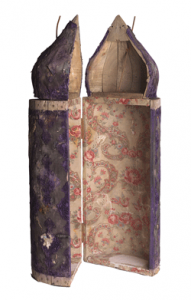Arts
Exhibit
Exhibit: Saving the Past

In May 2003, American troops entered Saddam Hussein’s intelligence headquarters and found a treasure—more than 2,700 Jewish books and thousands of documents dating from the mid-1500s to the 1970s. Shipped to the National Archives in Washington, D.C., for preservation and digitization, the discovery became known as the Iraqi Jewish Archive.
Twenty-four objects from the archive are showcased in the exhibit “Discovery and Recovery: Preserving Iraqi Jewish Heritage.” The objects, currently on display at New York’s Museum of Jewish Heritage–A Living Memorial to the Holocaust through May 18, reflect the rich 2,600-year history of Jews in Iraq.
Included are a minaret-shaped metal Torah case and Torah fragment, a 1793 Talmud imported from Vienna, a religious guidebook for women in Judeo-Arabic and a hand-painted Haggada. Also on display are a Hebrew elementary-school primer; school records from the last Jewish educational institution to close in Baghdad, in 1973; and photos of life-cycle events. Study texts for Shavuot recall anti-Jewish riots that broke out during that holiday and later persecutions. These led to the mass exodus of Iraqi Jews, primarily to Israel.
The exhibit opens with photos of Army troops wading through the four feet of water in which the artifacts were submerged and a few of the metal trunks that carried them to the National Archives.
What happens next is controversial. A 2003 agreement mandates turning the archives over to Iraq, but activists object. Gina Bublil-Waldman, president of Jews Indigenous to the Middle East and North Africa (JIMENA), asserted: “The best way for the Iraqi government to show its respect to its exiled Jewish community would be to return the [confiscated] objects.”
While remaining committed to returning the archive, the United States “understands the sensitivities surrounding these items,” said Michael Lavallee, United States State Department spokesperson. “We are open to any discussion the government of Iraq is willing to have on the future disposition.”










 Facebook
Facebook Instagram
Instagram Twitter
Twitter
Leave a Reply